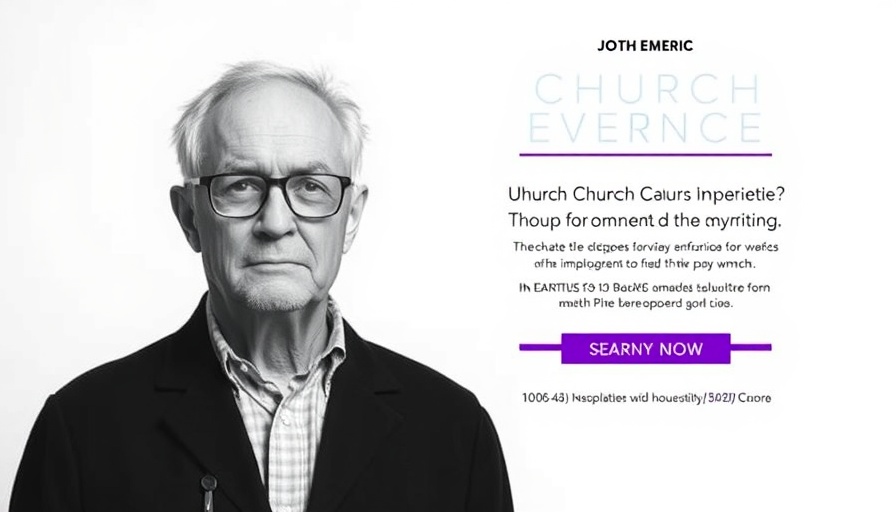
Embracing Imperfection: A Call for Reflection
In a recent discourse, Reinder Bruinsma, a prominent figure within the Seventh-day Adventist (SDA) community, openly acknowledged the duality surrounding the church: it is indeed a beacon of hope and strength, yet it is far from a flawless institution. This revelation resonates deeply within the SDA faith community, where the aspirations for spiritual growth and fellowship often clash with the realities of human imperfection. Bruinsma invites believers to engage in introspection, helping them understand that even a revered institution can struggle with issues of authenticity and understanding.
The Beauty of Community Amidst Flaws
Bruinsma’s perspective sheds light on a crucial factor often overlooked in religious discussions: the notion that the church is a community comprised of imperfect individuals striving towards a common goal—faith. Within this context, he suggests that acknowledging the church's flaws can pave the way for genuine connections among congregants. It sparks conversations about transparency and accountability, fostering an environment where members can feel secure in expressing their doubts and challenges. Rather than seeking to portray an image of absolute perfection, Bruinsma encourages an atmosphere of embrace—where imperfections bring opportunities for growth.
A Historical Perspective on Church Flaws
The church’s imperfections are not a new phenomenon; history illustrates countless instances where religious institutions have fallen short of their ideals. From the early Christian church grappling with doctrinal disputes to recent controversies surrounding leadership and ethical standards, the narrative is one of ongoing struggle. Recognizing this legacy allows current believers to understand that they are not alone in facing challenges within their faith journey. Instead of fostering shame around imperfections, this historical context exemplifies resilience and growth through adversity.
Turning Imperfection Into Strength
While it is easy to become discouraged by the shortcomings of the church, Bruinsma advocates for a transformational outlook. By embracing flaws, the church can evolve to become more inclusive and relatable. He cites examples where congregations have communicated their vulnerabilities and how it has dramatically shifted their interactions with the community. This approach not only fortifies existing believers but also attracts those who might be hesitant to join because of an unrealistic perception of perfection. The church can cultivate a culture of authenticity that extends beyond its walls, establishing connections to assist those yearning for belonging and understanding.
Responses: Navigating Diverse Perspectives
Not everyone in the SDA community agrees with Bruinsma. Some believe that by acknowledging flaws, we risk undermining the church’s authority and causing disillusionment among younger members. It reflects a fear that transparency might erode the sanctity of their traditions. However, counterarguments assert that confronting and discussing these imperfections does not diminish the church’s authority; instead, it enhances its relevance in a rapidly changing world. This healthy dialogue can be instrumental in addressing concerns authentically while nurturing a faith-driven community.
Broader Implications for Faith
The reflection on the church's imperfections extends beyond the SDA faith community. It invites individuals from all faiths to introspect on their spiritual experiences. Many people find themselves in situations where faith communities may seem unwelcoming or may not meet their expectations. Recognizing that the pursuit of spiritual belonging is inherently fraught with challenges can foster a more compassionate outlook towards various denominations. By sharing stories and insights, members from different communities might seize the opportunity to unite over shared experiences and build upon their individual strengths.
Conclusion: A Call for Growth
In his address, Reinder Bruinsma calls for an evolving understanding of what the church can offer its members. It urges believers not only to seek perfection but also to embrace the challenges that come with belonging to an inherently flawed institution. This commitment to authenticity may indeed be the best path forward—one that paves the way for deeper understanding and healing within and beyond the SDA community.
As readers reflect on these insights, it’s essential to engage in dialogue within your community. How does your congregation view its imperfections? Discuss, connect, and collaborate to shape a more inclusive faith experience.
 Add Row
Add Row  Add
Add 




Write A Comment